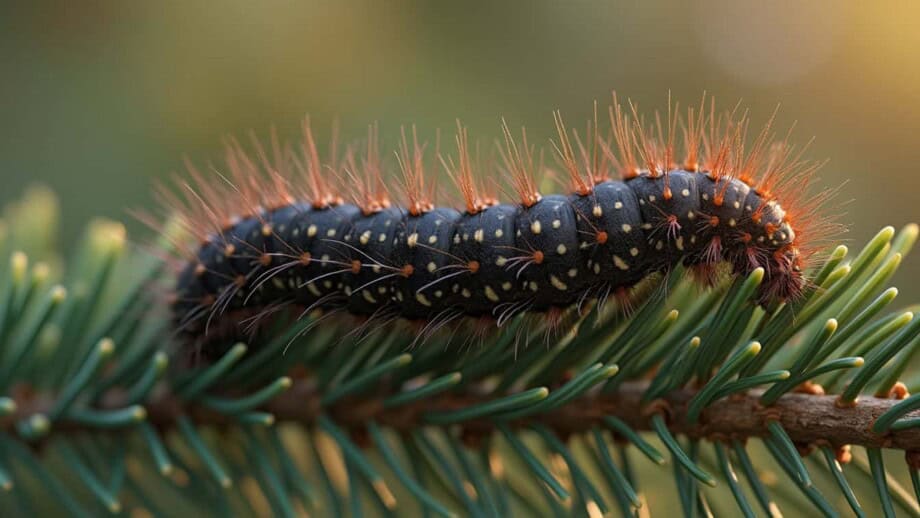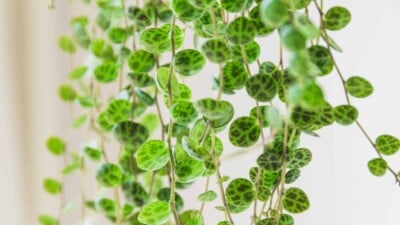Spruce Budworm
How to identify and effectively get rid of spruce budworm using proven, natural and organic control strategies.

The western spruce budworm, Choristoneura occidentalis, is the most widely distributed and destructive forest defoliator in western North America. In the Rockies, they most commonly infest Douglas-fir and white fir. Occasionally, they also attack Engelmann spruce, blue spruce and sub-alpine fir.
Identification
Adult moths are 1/2-inch long and have a wing-spread of 1-inch. Moths of both sexes are similar in appearance, although the females are a bit more robust than males. Both sexes fly. The gray or orange-brown forewings are banded or streaked, and each usually has a conspicuous white dot on the wing margin. Eggs are oval, light green and overlap like shingles.
Larvae develop through six stages. Newly hatched larvae are yellow-green with brown heads. In the next three stages, larvae have black heads and collars and orange or cinnamon-brown bodies. In the fifth stage, larvae have reddish-brown heads marked with black triangles, black collars and pale olive-brown bodies marked with small whitish spots. Mature larvae are 1-inch long, with tan or light chestnut-brown heads and collars and olive or reddish-brown bodies with large ivory-colored areas.
Life Cycle
Throughout most of its range, the Western Spruce Budworm completes one cycle of development from egg to adult within 12 months. Moths emerge from pupal cases usually in late July or early August; in the southern Rockies, adults often begin emerging in early July.
Adults mate and within 7 to 10 days the female deposits her eggs and then dies. Each female deposits approximately 150 eggs, usually on the underside of conifer needles. Eggs are laid in one to three-row masses containing a few to 130 eggs with an average of 25 to 40 eggs per mass.
Pest larvae hatch from eggs in about 10 days. Larvae do not feed, but seek sheltered places under bark scales or in and among lichens on the tree bole or limbs. Here, they spin silken tents in which they remain inactive through the winter.
In early May to late June, larvae leave their hibernacula to search for food. They first mine or tunnel into year-old needles, closed buds or newly developing vegetative or reproductive buds.
New foliage, which is normally the preferred food, is entirely consumed or destroyed before larvae will feed on older needles. Larvae become full grown in early July about 30 to 40 days after leaving their overwintering sites.
Larvae pupate in webs of silk they have spun either at the last feeding site or elsewhere on the tree. The pupal stage lasts about 10 days.
How to Control
- Budworm populations usually are held in check by a combination of predators, parasites, adverse climatic conditions or inadequate food supply.
- Spiders, insects and a variety of birds are important predators.
- Adverse weather conditions, particularly sudden freezes in late spring, may kill large numbers of larvae.
- A major factor in ending long-term outbreaks appears to be starvation from inadequate or nutritionally poor food sources. However, this may not be a factor in urban situations.
- Cultural practices (thinning, watering and fertilizing), which promote tree vigor, may help trees better withstand repeated attacks.
- Spinosad, the active ingredient in Monterey® Garden Insect Spray, is a highly effective bio-pesticide that is recommended for use against this tree pest. For best results, apply when young.
- The natural, soil dwelling bacterium Bacillus thuringiensis, or Bt-kurstaki, is particularly effective on damaging larvae. Use this easily applied spray early at the first signs of damage. Bt-K sprays do not harm honey bees or birds and are safe for use around pets and children.
- AzaMax contains azadirachtin, the key insecticidal ingredient found in neem oil. This concentrated spray (use 1-2 oz/ gallon) disrupts growth and development of budworm and has repellent and antifeedant properties. Best of all, it is relatively NON-TOXIC to spiders, beneficial insects and honeybees.
- Least-toxic botanical insecticides should be used as a last resort. Derived from plants which have insecticidal properties, these natural pesticides have fewer harmful side effects than synthetic chemicals and break down more quickly in the environment. Spray two to three weeks immediately following bud break, usually May-June.













